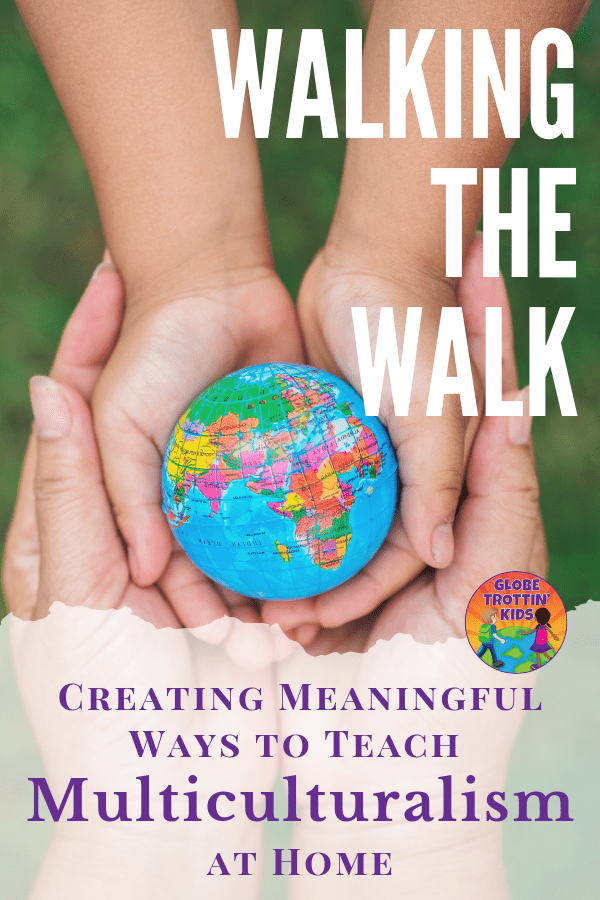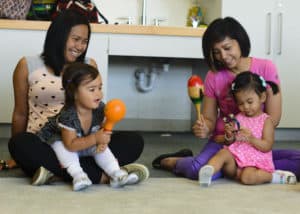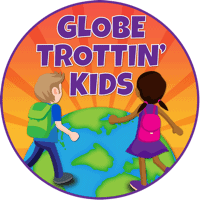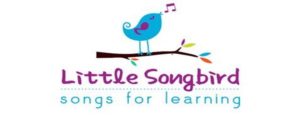Walking the Walk: Creating Meaningful Ways to Teach Multiculturalism at Home
Walking the Walk: Creating Meaningful Ways to Teach Multiculturalism at Home provides parents with information, tips, song and book recommendations to support three best practices for instilling a global view in the home.

Disclosure: This post contains affiliate links. If you click through, a small commission will be paid to Globe Trottin’ Kids at no additional cost to you.
We’re happy to welcome back guest blogger Lisa Heintz from Little Songbird: Songs for Learning. Lisa recently participated in our Global Learning Miniseries.
Her post, Sharing Many Cultures in the Elementary Classroom, provides educators with information and resources for creating a safe, inclusive, multicultural learning environment.
“I can see myself in all things and all people around me.” ~Sanskrit
I am fortunate to have had many life-expanding global experiences since my early days growing up in a small Midwestern town (which included exactly two Black families and no other races or cultures represented). It “took a village” to bring me to my current understanding; all the teachers, neighbors, friends, colleagues, relatives, travel, and remaining open to new experiences have afforded me a much broader and richer set of life experiences and understanding.
I have made countless efforts to be sure that my child has had opportunities to see the world through engagements with many people of various races, beliefs, and cultures. But these experiences are not limited to world travel. “Walking the walk” – making sure that our intentions to include other cultures in our kids’ lives are matched through our words and actions – includes creating a variety of opportunities to experience life beyond ones’ own backyard.
While many people in the US may not be travelers, the rest of the world is coming to us. As of 2015, Latinos* comprise nearly 18% of the US population, Blacks* make up about 13%, 6% are Asian*, 1% are American Native*, and Whites* make up the balance (around 62%) which is steadily decreasing each year. It has never been more important for our children to develop a strong sense of self, self-esteem, and respect for themselves and their heritage while developing the same respect for those who differ. Our neighborhoods and communities are quickly reflecting dynamic changes as people from around the globe join our country, bringing with them differing values, customs, music, food, languages, music, traditions, literature and ways of life.
“It is time for parents to teach young people early on that in diversity there is beauty and there is strength.”~ Maya Angelou

How can we best ensure an inclusive, respectful multicultural environment for our children? Consider these three best practices for instilling a global view in your home.
1. Learn what you don’t know. Be open to discovering your own misinformation.
Embrace your child’s naivety and curiosity, and do the research – begin with the cultures represented in your own family, neighborhood and school.
- Follow your family tree to understand your own racial and cultural heritage. Online programs can help you with genealogy (FamilySearch.org and AfriGeneas.com are both free and provide important records). DNA tests can now provide specific information regarding your ethnic makeup as well (like 23andme.com/DNA-ancestry or Ancestry.com).
- Explore your family’s heritage through books, movies, music, food, trips to relevant locations, historical museums, online resources, etc.
- Volunteer to visit your child’s class to share something of your culture (i.e., food, dress, music, craft, storytelling, books) throughout the year.
- Read local papers for information about events, import shops, ethnic markets, book talks and festivals related to relevant culture/s and attend them. Take pictures and ask questions.
- Visit museums; they are a treasure-trove of cultural artifacts and experiences.
- Become familiar with the beliefs, values, customs, foods, traditions (customs used on specific occasions) and holidays of relevant cultures from your neighborhood, school or community.
- Incorporate what you learn into daily experiences.
- Encourage dialogue about cultural similarities and differences.
- A Life Like Mine by DK (Dorling-Kindersley publishers)
- Kids’ Multicultural Craft Book by Roberta Gould
- International Cookbook for Kids by Matthew Locricchio
- “Family Photo Album” from Family Album by Two of a Kind
2. Cultivate an attitude of acceptance and respect for different cultures through everyday conversation. Be aware of your own discomfort.
As a parent, your attitude and actions toward differing races* or cultures* is what children will learn and imitate – even when your words are contrary to your actions. Multiculturalism is more than eating stir fry or having a piñata at a birthday party. It is about paying close attention to our own biases and misinformation (we all have them), educating ourselves about cultural differences, and engaging actively in conversations and activities with the intent to encourage exploration and inclusion beyond “tolerance,” and toward genuine appreciation for our differences.
This includes comparing and contrasting similarities and differences without judgment. Racial and cultural biases have been identified in children as young as age three. Even without discussing race, children naturally create categories – divisions – for themselves; it is part of the learning process to mentally put “like things together.” When it comes to social behavior, they create their own “us and them” mentality and they presume, “Those who look like me share my same interests and are OK; those who do not look like me do not share my interests and are less OK.” What constitutes similarity does not necessarily depend on race, but on any perceived likeness such as shirt color, choice of activities, food preferences, etc. And where other options don’t make sense to the child, they typically default to race (Bronson & Merryman, 2009).
By helping children associate neutral or positive descriptors with racial differences, parents can help create a more positive attitude about all kinds of differences. By the time children are nine years old, their self-identity and perception of others who differ from them are already solidified. It is never too early to broaden a mind.
But discussing issues of race and ethnicity can be muddled for some parents and unnerving for others. How young is too young to discuss such topics? What, exactly, should we say? Should we say anything at all? What if we say the “wrong” thing? What would that be?
There are at least three schools of thought on highlighting racial differences: One is that it is important to highlight racial differences with young children because those differences are already obvious (skin color is noticed as early as 6 months of age according to Katz in Bronson & Merryman, 2009), and you can highlight those differences without judgement (“Yes, her skin is darker than yours.”), or by incorporating your observation with a positive statement like, “President Obama is our nation’s first Black President. Anyone, regardless of skin color, can become whatever they want to be.” (Technically he is our first known biracial president!)
Another school of thought is that in highlighting racial differences you are inadvertently creating a division where one would not otherwise exist. White parents tend to avoid highlighting racial differences more than parents of other races. Unfortunately, this often sends a confusing message to children, implying that there is either something wrong with a person of another race or that there is something wrong with asking questions about race. A study of parents of 17,000 kindergartners indicates that 75% of White parents of kindergartners “rarely or never” discuss race with their children (three times more likely for non-White parents). And yet ALL children have natural curiosity.
A third framework is called “Diverse Environment” (the principle behind early school desegregation) and suggests that the environment itself is the positive message of diversity. If you raise your child in a home, school or community that is diverse and open to diversity, children will internalize by osmosis the concept that varying races working, learning and living together are acceptable. While this is a strong start, it is never enough. Repeated research shows that even in a diverse school or neighborhood students tend to interact primarily with their own race.
What we know from leaders in education and psychology is that explicit conversations of race and ethnicity work, and they matter at a very young age. Some researchers believe that there is a developmental “window” during which children are most likely to develop their sense of self, identity, racial and ethnic similarities and differences, after which they no longer absorb or incorporate much new information. So while it is vital to provide a “diverse environment” – the conversations, questions and frank answers all play a crucial role in your child’s developing sense of place in a global society.
- Invest in Multicultural (skin-tone) crayons. It is important for children to recognize their own identity as well as that of others and be able to accurately reflect themselves in their artwork.
- Incorporate foods and snacks from other cultures on a regular basis. Be sure to give them context by discussing what the food is, how it is made, and why its ingredients may be of importance (i.e., root vegetables grow easily in that country; salt has a special significance, etc.).
- Be sure that books and other print material in your home (particularly children’s books) reflect a variety of ethnicities and cultures, particularly those that reflect your own makeup and that of your child’s neighbors and classmates.
- Focus on the commonalities you find between people of your own culture and those from others. Remember to remark upon differences with interest and intrigue, or at least neutrality; avoid labeling or using a negative or mocking tone that might undermine the value of others’ unique experiences: “Yes, many women of the Muslim faith cover their heads with a special scarf called a hijab.”
- Learn significant words and phrases (I love you, please, thank you, etc.) in the language of relevant culture/s. There are free apps for PC, Mac, and cell users like iTranslate, Google Translate, or TripLingo.
- If you don’t know an answer to your child’s question, be honest. Say you don’t know, but then involve them in discovering the answer: search online together, ask others, read books to find out. Including your child in finding answers helps him learn to be resourceful, inquisitive, and fact-finding! If that’s not possible, always find the answer and share it with your child. If you later discover that you were mistaken, be sure to let your child know the correct information; it helps your child to see that adults also continue to learn and discover new things.
- Encourage cross-cultural friendships through play dates and shared experiences.
- Children Just Like Me by DK (Dorling-Kindersley publishers)
- Kids’ Multicultural Cook Book by Deanna F Cook
- Global Art by Mary Ann Kohl
- Whoever You Are by Mem Fox
- If You Lived Here: Houses of the World by Giles Laroche
- It’s OK to Be Different by Todd Parr
- “Take Good Care of Each Other” by Cathy Fink & Marcy Marxer
- “Every Little Bit of You” from Come Make a Circle 3 by Susan Salidor
- “Assam Aleykum” (a song of peace) by DARIA
3. Infuse your choices, responses and activities with a multicultural perspective. Always model the type of attitude, words and behavior you wish to see in your children.
Through knowledge-gathering and integration of global content into your home and activities you will create a supportive, inclusive environment for your child.
- Engaging your children in learning about their own heritage, values, customs and traditions not only builds their self-esteem and cultural pride, but it enhances the way they view and embrace the cultural differences in others. The younger they are when they begin to develop their curiosity and acceptance the better able they will be to live and succeed in our ever-changing world.
- Focus on a “strengths and gifts” perspective when discussing your child’s abilities, beliefs and contributions to his world. Identify strengths and gifts in others in your child’s circle. There are many qualities to observe and celebrate in others, regardless of race or culture, that are typically embraced by all: compassion, loyalty, friendship, honesty, integrity, helping others, kindness, patience, hard work, doing your best, etc.
- Explicitly acknowledging and honoring those qualities you value that you see in your child and others goes a long way toward developing self-esteem, self-acceptance, appreciation and acceptance of others. Through intentional language and active conversation about similarities and differences, you help your child see herself as the special, unique person she is–while seeing the same uniqueness and gifts in others, too.
- Kids Songs Around the World: A Mama Lisa book by Lisa Yanucci
- A Ticket Around the World by Natalia Diaz & Melissa Owens
- “Part of One Family” from Pizza Pizzazz by Peter & Ellen Allard
- “Family Tree” from Friends by Two of a Kind
- ”Everyone Has Strengths to be Proud Of” from My Turn, Your Turn by Cathy Bollinger
A sampling of multicultural songs & albums available from Little Songbird: Songs for Learning
Multiple languages
Latin America/Spanish
Africa
African-American
Jewish/Hebrew
- “Shalom Chaverim” from Come and Make a Circle 2 by Susan Salido
- Shanah Tovah, Shanah M’Tukah: Songs for the Jewish Year by Joanie Calem
French
About the Author
Lisa Heintz is an elementary educator and edupreneur. Her site, Little Songbird: Songs for Learning (LSS4L), currently provides nearly 1,000 song and album downloads of quality children’s music from a variety of independent artists. LSS4L is excited to be adding more music, book recommendations, and lesson plans/activities to accompany the songs on the site to make integrating music into daily life and curriculum a 1-stop shopping experience! Do you know of children’s song recordings in languages other than English that we should consider for our site? Let us know.
* While terminology relating to culture, ethnicity and race can often be complex, blurry or sometimes inaccurately used, for the sake of this post “race” suggests a group of people who share common physical features and genetic background. “Ethnicity” suggests a social group of people who share a common nationality, language or cultural traditions. “Culture” refers to the rituals, arts and beliefs that identify a group and are passed down through generations.
“Black,” “White,” “Latino,” “Asian,” and “American Native” refer to American residents who self-identify as such, but are broadly used to differentiate race in the simplest visual terms. For more on ethnicity and race definitions: http://www.diffen.com/difference/Ethnicity_vs_Race
Photo credits: All cover art provided by the artists. Book covers obtained from booksellers as linked.
http://www.aviano.af.mil/News/Photos/igphoto/2001258671/
Resources:
Bronson & Merryman, 2009: http://www.newsweek.com/even-babies-discriminate-nurtureshock-excerpt-79233
2015 US Racial Demographic statistics: http://kaiserf.am/2vgzQg8

